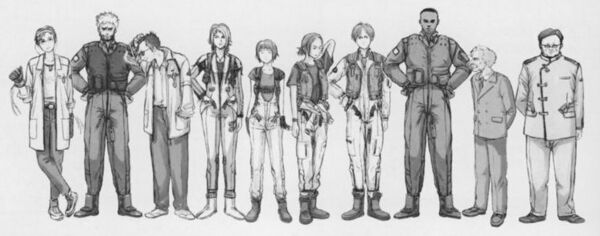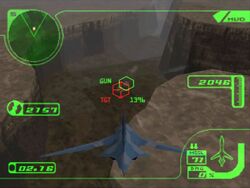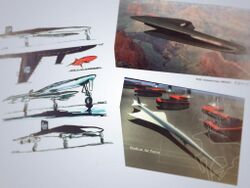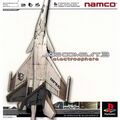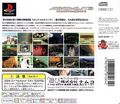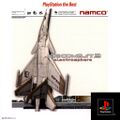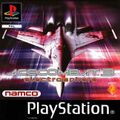Ace Combat 3: Electrosphere
Ace Combat 3: Electrosphere[a] is the third installment in the Ace Combat franchise, developed by Namco for the PlayStation. It is notable for its futuristic science-fiction-inspired world compared to the modern settings in other Ace Combat games. Electrosphere is the only game in the franchise that released in two distinct forms.
The Japanese version of Electrosphere was released in 1999 on two CD-ROMs exclusively in Japan. The campaign featured 52 missions split between five different paths depending on the player's decisions. The story was only available in Japanese audio and text; it centered around the "Intercorporate War" in Strangereal's 2040, later revealed to be a simulation.
The international version of Electrosphere was released in 2000 on one CD-ROM in North America and Europe. This version was planned to be a full localization of the 52-mission story campaign featured in the Japanese version,[5][6] but the localization was canceled. Instead, the campaign has only 36 missions in a linear path with no branching. The Japanese story, voice acting, and cutscenes were removed; a different story was added through text only.
Future Ace Combat games and material, especially Ace Combat 7: Skies Unknown and Aces At War: A History 2019, have referred to story details and characters exclusive to the Japanese version of Electrosphere. This has led the community to consider the Japanese version canon, and the international version non-canon, to the rest of the Strangereal universe. Fans' desire to experience the Japanese story has led to multiple fan translation projects and requests for an official remake.
Plot
Japanese version
Synopsis
The story of the Japanese version of Electrosphere takes place on Strangereal's Usean continent in 2040.[7] By this time, Usea's national governments, while still present, have been effectively replaced by multinational corporations. The most powerful of these corporations are the rivals Neucom Incorporated and General Resource Limited; both have their own military forces and claims to territory on the continent.
Sometime in the 2030s, territorial disputes between Neucom and General Resource began to escalate. The peacekeeping Universal Peace Enforcement Organization (UPEO), under the authority of the Neo United Nations, has maintained relative peace between the corporations. At the start of the game, Neucom performs large-scale strikes against General Resource, pushing UPEO to use force to prevent further escalation, leading to a three-way war. As the game progresses, a terrorist organization named Ouroboros is revealed to have sparked the conflict between the two companies.
The player takes control of Nemo, ostensibly a new recruit for UPEO. As the story progresses, the player is given opportunities to defect from UPEO and join Neucom, General Resource, or Ouroboros. These decisions change the path of the story, the fates of multiple characters, and the ending the player receives. After the player witnesses all five endings, a final cutscene reveals that Nemo was actually an artificial intelligence created by Simon Orestes Cohen. The entire Intercorporate War was a simulation Simon designed to test whether an artificial copy of another character, Abyssal Dision, would be killed in the war. Since all five endings result in the AI Dision's death, Simon is pleased with the results and is assumed to release Nemo into the real world.
Characters
- Nemo is the silent player character of the game, later revealed to be an AI within a simulation. Originally a member of UPEO, Nemo can defect to any of the other organizations in the conflict. Although the player is free to choose any aircraft for Nemo, the game's cover depicts an Su-37 Super Flanker, implying that this is Nemo's canon aircraft.
- Rena Hirose is one of Nemo's wingmen in UPEO. She suffers from the Silverstone Disease, making direct sunlight lethal to her. As such, she flies a custom-made Su-37 Super Flanker-R. She has a prior attachment to Dision and a secret project known only as "Night Raven."
- Erich Jager is another pilot in UPEO. He strongly dislikes Commander Park and his hawkish orders.
- Fiona Chris Fitzgerald is another pilot in UPEO. She is the younger sister of Neucom ace pilot Cynthia Fitzgerald.
- Gilbert Park is the commander of the UPEO forces.
- Gabriel William Clarkson is the official representative of UPEO.
- Cynthia Bridgitte Fitzgerald is Fiona's older sister and the only ace pilot in Neucom. She flies an R-102 Delphinus #2, which she later replaces with a newer R-103 Delphinus #3.
- Simon Orestes Cohen is a prominent member of Neucom's military research and development division. He previously worked for General Resource and had an unknown attachment with Yoko. He is later revealed to have created Nemo.
- Abyssal Dision is the top ace of General Resource's air force, and the main antagonist of the game. He flies a customized F-15S/MT Eagle+ for most of the game. Halfway through the game, it is revealed that this is actually an artificial copy of Dision that lives within the Electrosphere network and leads Ouroboros; the original Dision was killed several years before the game's events.
- Keith Bryan is Dision's wingman and a fellow ace of General Resource.
- Yoko Martha Inoue was a neuroscientist who researched sublimation while working for General Resource. She had an unknown attachment with Simon and a romantic relationship with Dision. She was killed several years before the game's events; Simon believed Dision was responsible for her death, leading him to create Nemo.
Cultural references
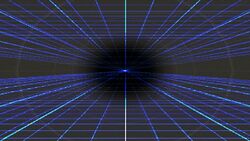
The plot of Electrosphere has been compared to the Ghost in the Shell anime films, Production I.G.'s most famous franchise, especially since Production I.G. was responsible for Electrosphere's in-game cutscenes. Possible references include the subterranean city Geofront and the uploading of a brain/consciousness to a computer (referred to as "sublimation" in Electrosphere and "ghost-dubbing" in GitS). The Geofront may have also been a reference to a location in Neon Genesis Evangelion.
The game's style is reminiscent of the WipEout video game series, especially the head-up display. The logos of UPEO, Neucom, General Resource, and Ouroboros bear resemblance to the works of The Designers Republic.
Ridge Racer V, Ridge Racer 6 and Ridge Racer 7 contain many references to Electrosphere, such as billboards with the General Resource and Data Swallow logos; the UPEO, Data Swallow, and Electrosphere logos plastered on various cars; and cars sponsored by Neucom and General Resource. In Ridge Racer 7, Neucom and General Resource also specialize in nitrous oxide engines.
International version
Some plot elements from the Japanese version of Electrosphere are still included in the international version, with some notable differences. For example, Neucom was renamed to Neuwork, and the leader of Ouroboros is a different AI named Aurora. In this version, the player exclusively flies for UPEO and works for most of the game to prevent "Neuwork" from trespassing on General Resource territory before Ouroboros is discovered. After that, the player is sent to hunt down Aurora and destroy Ouroboros to bring peace to the world.
Gameplay
Electrosphere plays in a similar manner to its predecessors, but with several additions that would become staples of the series. The camera can be rotated in a 360° range around the player, and a large assortment of weapons, including guns and main missiles, can be chosen freely before each mission. Wingmen cannot be selected, but are instead dictated by the story. Missions combined radio chatter from both allies and enemies to expand the narrative.
Electrosphere is notably the only game in the series that featured a mission set in outer space, complete with a different physics model on the handling of aircraft in a zero-gravity situation.
The Japanese version elaborates on the mission branching mechanics of Ace Combat 2 by allowing the player to join one of four factions through the story. Specific missions gave the player the ability to decide on remaining with one faction or switching to another. The Clear Rank system was expanded upon, where D ranks are specifically earned by failing the mission's main objective but do not require the mission to be restarted. In addition, certain circumstances unlocked hidden missions to be played, similar to AC2.
Development
Original release
The Japanese version of Ace Combat 3: Electrosphere was released on May 27, 1999. It was packaged into two CD-ROMs: the first CD contained the UPEO and General Resource missions and the second CD contained the Neucom and Ouroboros missions. Supplementary materials included the Mission & World View Guide Book and Mission 00. All Japanese copies of the game also included the Photosphere booklet.
This version of Electrosphere received a budget re-release under PlayStation's The Best range on December 7, 2000.[8]
Localization
- "I've only worked on a handful of titles. I ... was supposed to do Ace Combat 3 but the project was canned after 1 demo scene"
- ― Agness Kaku on her video game translation work[5]
- "I was brought in to do a demo translation of a story chapter by people who were supposedly contracted to write the screenplay. Soon after, Namco decided to lighten the budget by ditching much or all of the plot content for the non-Japanese release."
- ― Angess Kaku on the localization for Electrosphere[6]
The international version of the game was released on a single CD-ROOM in 2000: on January 21 in PAL regions[3] and on March 3 in the United States.[3][4] The localization of the game was subcontracted to the Japanese company Frognation, who contacted the veteran translator Agness Kaku and produced several demo voice-over clips. Early in the localization process, Namco suddenly cut its funding and removed most of the game's story.[6][9]
There has never been an official reason stated by Namco, Frognation, or Agness Kaku on why the funding was cut. It is believed that a lack of sales led to Namco's decision. Air Combat sold over 2.2 million copies, but Ace Combat 2 only sold a little over 1 million copies.[10] By comparison, the Japanese version of Electrosphere had a much larger story with many more cutscenes and voice-acted lines than Air Combat and Ace Combat 2 combined, as well as a higher total mission count. Despite the higher production cost, Electrosphere sold a little over 1.1 million copies including the international versions, barely surpassing Ace Combat 2 and failing to match Air Combat. Namco may have expected much larger sales figures for the game, potentially resulting in their decision to halt the full localization of the game.
Namco made their decision after they had already started advertising the game's expansive storyline in regions outside of Japan, resulting in backlash from fans of the series who were expecting the game's full localization.[9] Despite this, the international version still received positive critical reception upon its release.[4]
Remake
Due to the international version's lack of the full Japanese story, Ace Combat fans have repeatedly asked Namco and later Bandai Namco to re-release or remake Electrosphere with full localization. The company has repeatedly denied such requests.
When asked by GameDaily in 2006 about the possibility of remaking Electrosphere, Naoto Maeda said: "As far as a re-make of Ace Combat 3 is concerned, we have no plans to do this at this time. The development team is aware that there are a lot of fans out there that really loved Ace Combat 3. If enough voices calling for a re-make were gathered and various issues could be resolved, then I think it might be worth it."[11]
Brand director Kazutoki Kono was asked by a fan during an Ace Combat Infinity signing event in 2014 about Electrosphere and a potential remake. Kono explained that the team was too small to support the massive localization that Electrosphere required and, if it were to happen, it would be more difficult than re-releasing Ace Combat 04: Shattered Skies, Ace Combat 5: The Unsung War, and Ace Combat Zero: The Belkan War combined.[12]
Fan translations
In June 2009, a fan-driven project was initiated by a group of people known as "Team NEMO" in order to fully translate Electrosphere.[13] They published a first draft of all in-mission scripts translated into English in August 2010.[14] After bringing on programmers to inject the translations into the game, the first demo of a translation patch was released in December 2014.[15] After more revisions and releases, over 17 years after the Japanese version's release, Team NEMO released the first full translation patch for both discs of Electrosphere on December 14, 2016, with a small hotfix released the following day.[16] This marked the first time the Japanese version of Electrosphere could be played in its entirety in a language other than Japanese, as well as the first time an Ace Combat game received a translation patch (whether official or fan-made). The patch released by Team NEMO primarily translated the subtitles for spoken lines; it did not translate many of the user interface elements, cutscene videos, or lore information included in the two discs. The patch also changed the music that plays during the missions "Claustrophobia" and "Betrayal". As of May 2023, Team NEMO has not released an update to their patch.
In November 2021, another group of fans known as "load word team" announced their ongoing work for a new translation patch that would support English, Castilian Spanish, and Italian.[17] The Italian version of the patch was released one month later.[18] Further details on the English and Spanish patches were revealed on May 8, 2023,[19] and the patches themselves were released on May 27, celebrating the 24th anniversary of the game's release.[20] Compared to Team NEMO's patch, load word team's patch features an updated localization, translates the user interface, search engine, archive list, and text inside some cutscenes, fixed the music that plays in "Claustrophobia" and "Betrayal", and also translates AppenDisc. In collaboration with load word team, LonelyChaser Fansubs also released a translated version of Mission 00.[21]
Aircraft
Unlike any other game in the Ace Combat franchise (excluding Ace Combat Advance), Electrosphere features exclusively original fictional aircraft. A majority of them are based on real designs, such as the F-22C Raptor II (based on the F-22A Raptor) and the EF-2000E Typhoon II (based on the Typhoon). There are also many aircraft whose designs were completely fictional such as the R-101 Delphinus #1, X-49 Night Raven, UI-4054 Aurora, and more.
In both versions of the game, new aircraft are only unlocked after completing certain campaign missions. Unlike other Ace Combat games, aircraft are immediately available once they're unlocked; there is no credits system. In the Japanese version of the game, aircraft are further restricted by the organization the player is affiliated with at that time. For example, the player can only fly Neucom aircraft when allied with Neucom.
In addition to selecting an aircraft before each mission, the player can swap out their standard missiles and guns. The specific weapons available depend on the aircraft being used. However, unlike Ace Combat 2 before it, the player cannot change their wingmen's aircraft or armaments.
Galleries
Box Art
Miscellaneous
Wallpaper depicting a squadron fielding the R-101 Delphinus 1
Trivia
- The HUD for Electrosphere was ported to and modified in Ace Combat Infinity for players who flew the R-101 Delphinus #1 or the X-49 Night Raven (and their respective Special Aircraft).
- In 2011, Bandai Namco retconned Electrosphere into the United Galaxy Space Force series as the first chronological game to take place.
Footnotes
- ↑ Ace Combat 3: Electrosphere (エースコンバット3 エレクトロスフィア Ēsu Konbatto San Erekutorosufia)
References
- ↑ File:AC3 JP Box Art.jpg.
- ↑ https://www.jp.playstation.com/software/title/slps02020.html
- ↑ 3.0 3.1 3.2 3.3 3.4 Ace Combat 3: Electrosphere (1999) PlayStation release dates. MobyGames. Retrieved on December 14, 2016.
- ↑ 4.0 4.1 4.2 Ace Combat 3. IGN. Published on March 13, 2000. Retrieved on December 14, 2016.
- ↑ 5.0 5.1 John Szczepaniak. "Interview with the wolfgirl - Agness Kaku". Hardcore Gaming 101. Published on January 2012. Archived from the original on 25 January 2012. Retrieved on 11 March 2018.
- ↑ 6.0 6.1 6.2 specialty writing \ AC3. *hibernium.com. Retrieved on December 14, 2016.
- ↑ The interface in the main menu screen is dated 2040.
- ↑ https://www.jp.playstation.com/software/title/slps91214.html
- ↑ 9.0 9.1 AC3's official localization: the post-mortem. USEA Today. Published on April 18, 2014. Retrieved on December 14, 2016.
- ↑ 『エースコンバット』シリーズ全世界累計1,000万本突破!. Retrieved on April 14, 2015.
- ↑ Published on March 24, 2006. This quote has been lost to time due to GameDaily being acquired by Engadget; its content is no longer available. See Talk:Ace Combat 3: Electrosphere#Interview for more information.
- ↑ EchoFox. "I met Project Ace's Kono in London and it was awesome". AceCombatSkies.com. Published on 17 June 2014. Archived from the original on 14 December 2016. Retrieved on 14 December 2016.
- ↑ Connecting... USEA Today. Published on June 2, 2009. Retrieved on December 14, 2016.
- ↑ Mission Complete. USEA Today. Published on August 17, 2010. Retrieved on December 14, 2016.
- ↑ AC3E IE Playable Demonstration Release. USEA Today. Published on December 25, 2014. Retrieved on December 14, 2016.
- ↑ AC3e IE Discs 2/2 《 Heaven and Earth 》. Published on December 14, 2016. Retrieved on December 14, 2016.
- ↑ "Ace Combat 3 electrosphere". load word team. Published on 1 November 2021. Retrieved on 27 May 2023.
- ↑ "La patch 3.0 in italiano per Ace Combat 3" ["Italian patch 3.0 for Ace Combat 3"]. load word team. Published on 30 December 2021. Retrieved on 27 May 2023.
- ↑ "Announcement of new Ace Combat 3 Electrosphere fan translation in English and Spanish!". load word team. Published on 8 May 2023. Retrieved on 27 May 2023.
- ↑ "Ace Combat 3 Electrosphere, A Complete Fan Translation". load word team. Published on 27 May 2023. Retrieved on 27 May 2023.
- ↑ MartyMcflies. "Ace Combat 3: Electrosphere - "Mission 00" & "AppenDisc Night Raven"". LonelyChaser Fansubs. Published on 26 May 2023. Retrieved on 27 May 2023.
| Ace Combat games | |
|---|---|
| Numbered Series | |
| Secondary Games | |
| Spin-Off Games | |
| Other Games | |
| Unreleased | |

